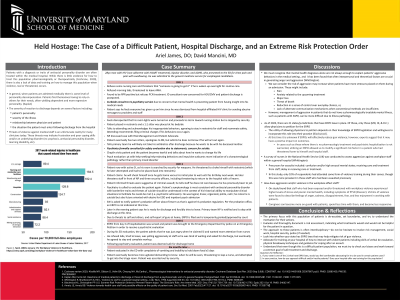Systems-Based Practice and Administrative Psychiatry
Session: Poster Session
(182) Held Hostage: The Case of a Difficult Patient, Hospital Discharge and an Extreme Risk Protection Order

Trainee Involvement: Yes

Ariel James, DO
Psychiatrist
University of Cincinnati Medical Center, United States
David C. Mancini, MD
Clinical Psychiatrist
Univeristy of Maryland School of Medicine
Baltimore, Maryland, United States
Presenting Author(s)
Co-Author(s)
Abstract
Background/Significance:
Patients with a diagnosis or traits of antisocial personality disorder are often treated within the medical hospital. While there is not significant evidence for how to treat this population pharmacologically or therapeutically (Cochrane, 2020), there is also a lack of data and training on how to manage this population when violence, real or threatened, occurs.
Case/
Methods:
In this case we will discuss a 28-year-old male with HIV (non-adherent with treatment) and a chart history of bipolar disorder who self-presented to the emergency department with complaints of painful swallowing and was admitted for esophageal candidiasis. Throughout the course of his brief three-day admission, the patient intermittently refused care, was verbally assaultive, repeatedly required the presence of security, and threatened gun violence against staff and the hospital.
The primary team initially questioned if the patient’s psychiatric illness was contributing to his behaviors, but then later formally consulted due to patient’s expressed desire to kill himself via antiretroviral non-adherence. Evaluation by three different psychiatrists pointed to likely antisocial traits and recommendation that the patient could continue care with his established outpatient psychiatrist. The complexity of the case escalated after he threatened to shoot himself and staff with a gun over refusal to be discharged by the medical service. After much discussion, an Extreme Risk Protection Order was filed in order to discharge the patient from hospital.
Discussion:
A psychiatry textbook published in the UK (Brown, 2015), lists several behavioral interventions that can be implemented when interacting with violent or aggressive patients. With our patient, many of these tools were used, but his adversarial behaviors continued throughout the admission. This case demonstrates the need for discussion amongst treating teams and possibly risk management when there is potential for escalation of violence when discharge is imminent. Other questions are also brought to mind including how staff interactions with this patient population might affect staff morale and future patient care. In addition to this, we must consider the conscious or unconscious bias that can take place when caring for “difficult” patients and how that affects their health equity at large.
Conclusion/Implications:
Patients with diagnosed or suspected personality disorders can be quite challenging for medical teams to deal with in the hospital. This is multifactorial due to lack of exposure, training, or education about this pathology. More training and education is needed on how best to manage these patients and also determining when psychiatry and/or legal actions are needed.
References:
Brown, P., Thomasson, R. (2015). Psychiatry: Breaking the ICE: Introductions, Common Tasks and Emergencies for Trainees. Wily. https://ebookcentral.proquest.com/lib/nddn-ebooks/deatil.action?docID=4036306
Cochrane review 2020; Khalifa NR, Gibbon S, Vollm BA, Cheung NH, McCarthy L. Pharmacological interventions for antisocial personality disorder. Cochrane Database Syst Rev. 2020 Sep 3;9(9): CD007667. doi: 10.1002/14651858.CD007667.pub3. PMID: 32880105; PMCID: PMC8094881

